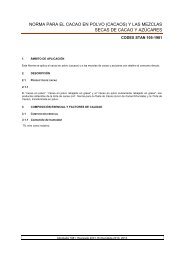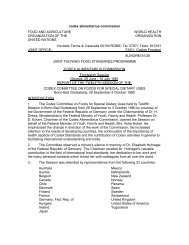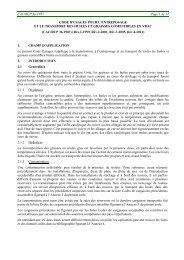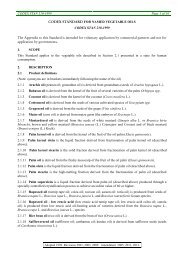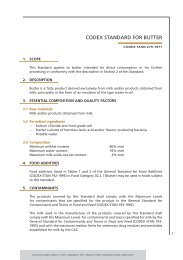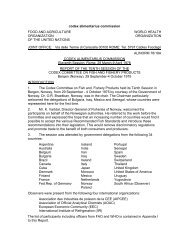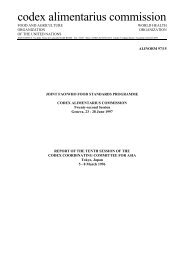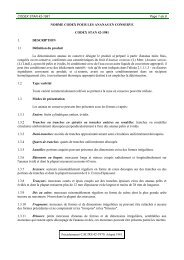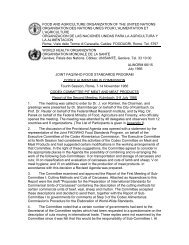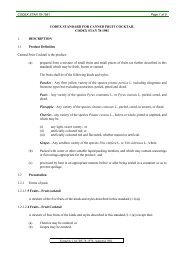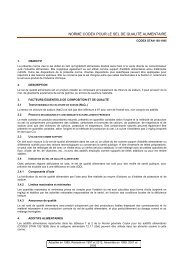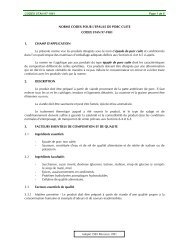REP13/FH JOINT FAO/WHO FOOD STANDARDS PROGRAMME ...
REP13/FH JOINT FAO/WHO FOOD STANDARDS PROGRAMME ...
REP13/FH JOINT FAO/WHO FOOD STANDARDS PROGRAMME ...
Create successful ePaper yourself
Turn your PDF publications into a flip-book with our unique Google optimized e-Paper software.
<strong>REP13</strong>/<strong>FH</strong> 2<br />
9. The Committee considered the report of the in-session Working Group (CRD 26) and agreed to<br />
endorse the hygiene provisions with some amendments, aimed at providing more precise text from a<br />
scientific and technical point of view and consistency with other Codex texts. The Committee did not<br />
endorse the provisions in paragraph 6.5 for the cleaning of utensils and agreed to request further clarification<br />
from CCNEA on the scientific basis for the measures prescribed.<br />
10. The Committee agreed to forward the endorsement of the hygiene provisions of draft Regional Code<br />
of Practice for Street-Vended Foods to CCNEA for their consideration (Appendix II).<br />
11. The Committee further noted that several comments were received on sections other than on food<br />
hygiene and agreed that these would be submitted to CCNEA for their consideration.<br />
MATTERS ARISING FROM THE WORK OF <strong>FAO</strong>, <strong>WHO</strong> AND OTHER INTERNATIONAL<br />
ORGANIZATIONS (Agenda Item 3) 4<br />
PROGRESS REPORT ON THE <strong>JOINT</strong> <strong>FAO</strong>/<strong>WHO</strong> EXPERT MEETINGS ON MICROBIOLOGICAL RISK ASSESSMENT (JEMRA)<br />
AND RELATED MATTERS (Agenda Item 3a)<br />
12. Referring to the <strong>FAO</strong>/<strong>WHO</strong> Expert Meeting on the Public Health Risks of Histamine and Other<br />
Biogenic Amines from Fish and Fishery Products (Rome, Italy, 23-27 July 2012) 5 which addressed the issue<br />
of histamine criteria in various fish and fishery products and examined their public health and trade impact,<br />
the Representative of <strong>WHO</strong>, speaking on behalf of <strong>FAO</strong> and <strong>WHO</strong>, provided the Committee with an overview<br />
of the discussions and conclusions. Specific reference was made to the conclusions on the no-observedadverse-effect<br />
level (NOAEL) for histamine, the link between sensory quality and histamine levels, and the<br />
control measures for mitigation of the risk of scombroid fish poisoning (SFP), including the performance of<br />
various sampling approaches. The Representative further informed the Committee that <strong>FAO</strong> and <strong>WHO</strong> were<br />
working to make the mathematical tools that were used in this expert meeting to design and assess different<br />
sampling plans available in a user friendly format.<br />
13. The Delegation of Japan noted that the Committee for Fish and Fishery Products (CCFFP) had<br />
established an electronic working group to study the meeting report, with the objective of developing<br />
recommendations on histamine criteria including proposed sampling plans for consideration by its next<br />
session and encouraged all the CC<strong>FH</strong> delegations to study the Exert Meeting report, especially with regard<br />
to sampling plans, and to closely communicate on this matter with the CCFFP delegations in their countries.<br />
The importance of communicating with other Codex Committees both formally and informally was strongly<br />
reiterated by the Chairperson.<br />
14. In response to a question on other biogenic amines, the Representative of <strong>WHO</strong> noted that the Expert<br />
Meeting had considered these and concluded that further data was necessary before an evaluation of the<br />
public health risks of these other biogenic amines could be undertaken.<br />
15. The Representative of <strong>WHO</strong> also referred to a summary report of the pilot project to enhance<br />
participation in the development of Codex texts that had been used to support the revision of the Codex<br />
principles and guidelines for the establishment of microbiological criteria (Agenda Item 4). In particular the<br />
Representative recognized the time and effort contributed by all the working group members who<br />
participated in the initiative noting that an evaluation of this initiative would be completed after this Session of<br />
the Committee. The Representative noted the willingness of <strong>FAO</strong> and <strong>WHO</strong> to post the examples on their<br />
respective websites if the Committee decided that was the best location for them. The Chairperson<br />
expressed his appreciation to all involved and noted the value of this approach, including its potential value<br />
for certain work in the future.<br />
16. The Representative of <strong>WHO</strong> also noted that <strong>FAO</strong> and <strong>WHO</strong> had tentatively planned to address the<br />
request from the 43 rd Session to provide technical support on the development of the Annex on the statistical<br />
and mathematical considerations for elaborating microbiological criteria in 2013 (Agenda Item 4), pending<br />
confirmation and further information from the Committee on the need for and scope of this work.<br />
17. With regard to development of a web-based tool to assess the performance of microbiological<br />
sampling plans, the Committee was informed that the tool was now available (www.mramodels.org/sampling)<br />
and <strong>FAO</strong> and <strong>WHO</strong> welcomed any feedback from delegations on the tool.<br />
4<br />
5<br />
CX/<strong>FH</strong> 12/44/4; CX/<strong>FH</strong> 12/44/5.<br />
Report available at: http://www.fao.org/food/food-safety-quality/a-z-index/histamine/en/



